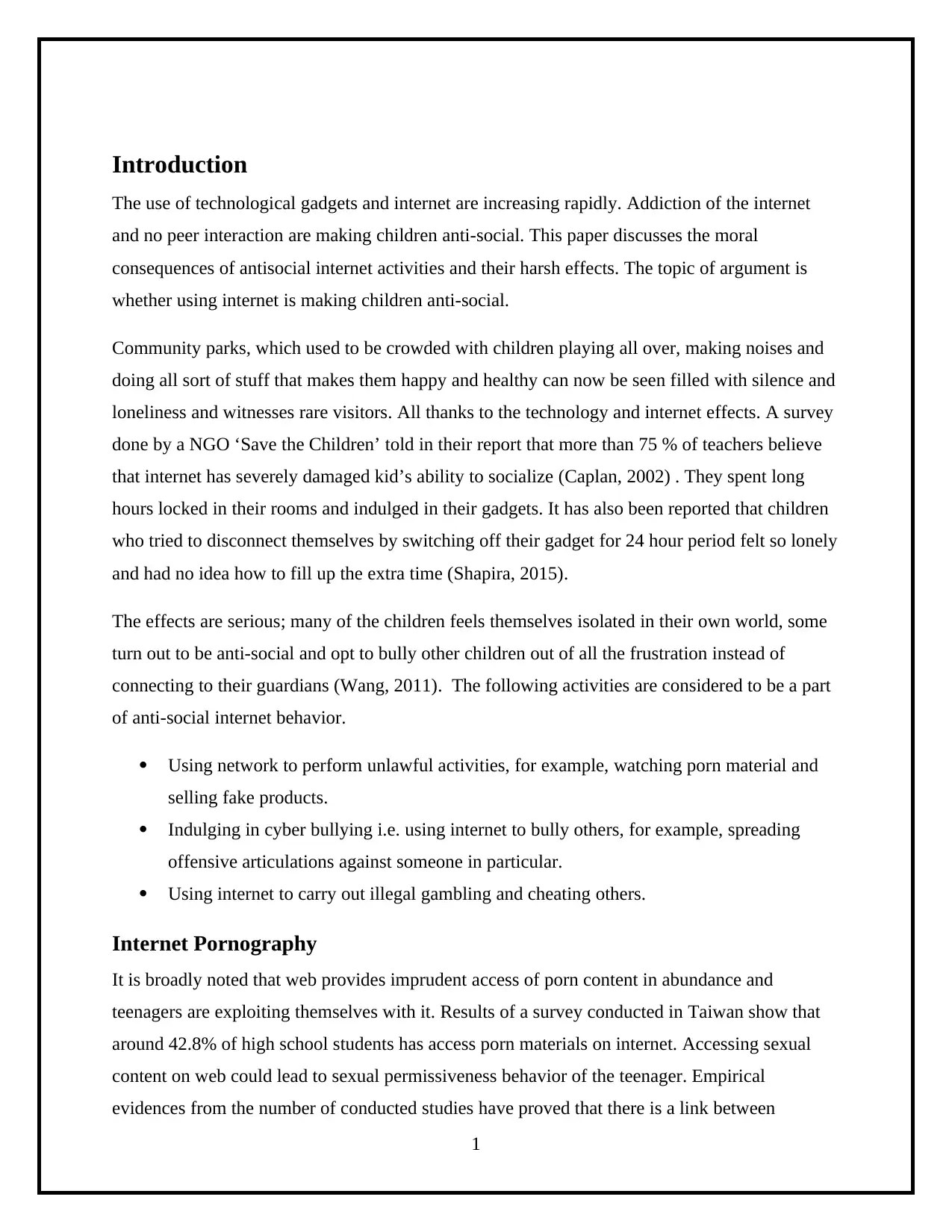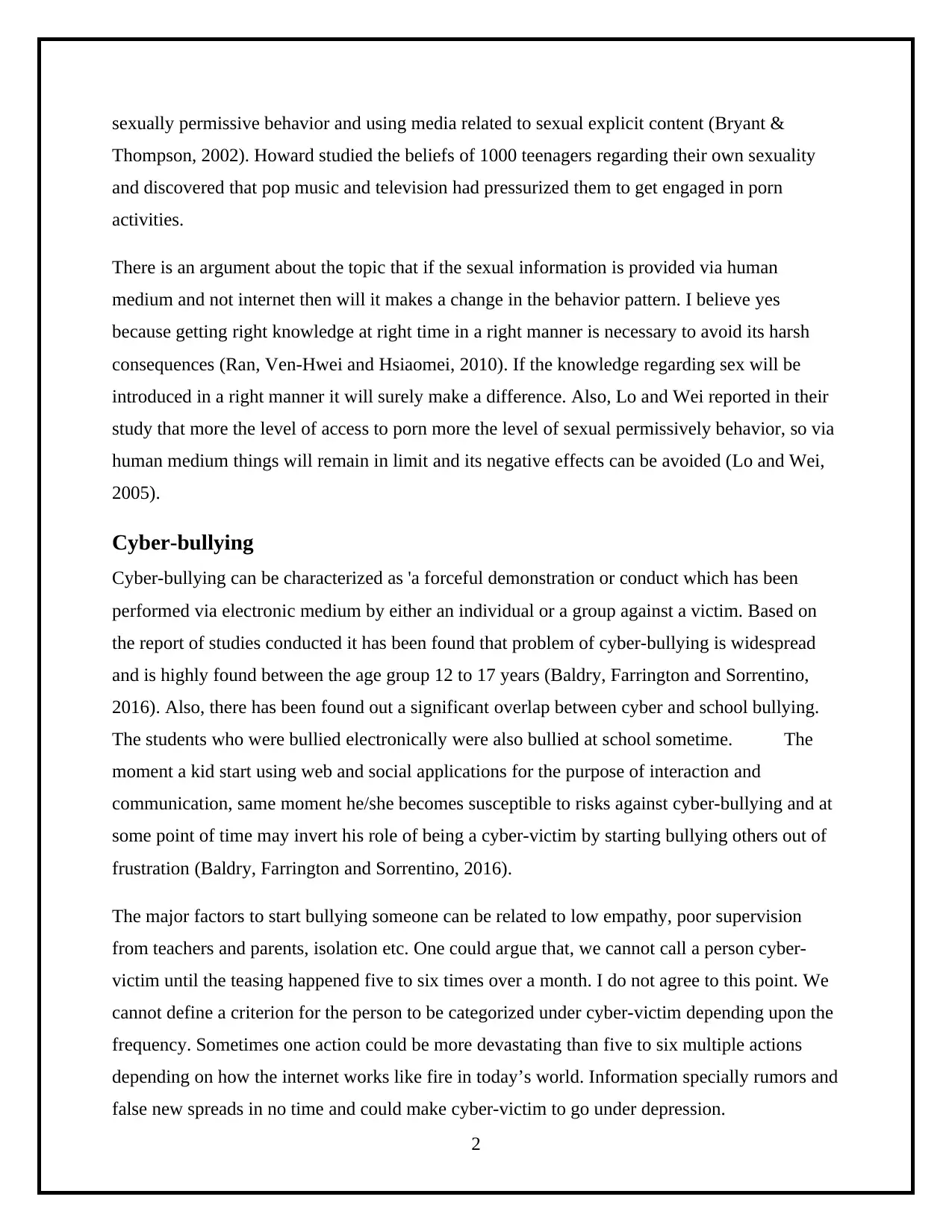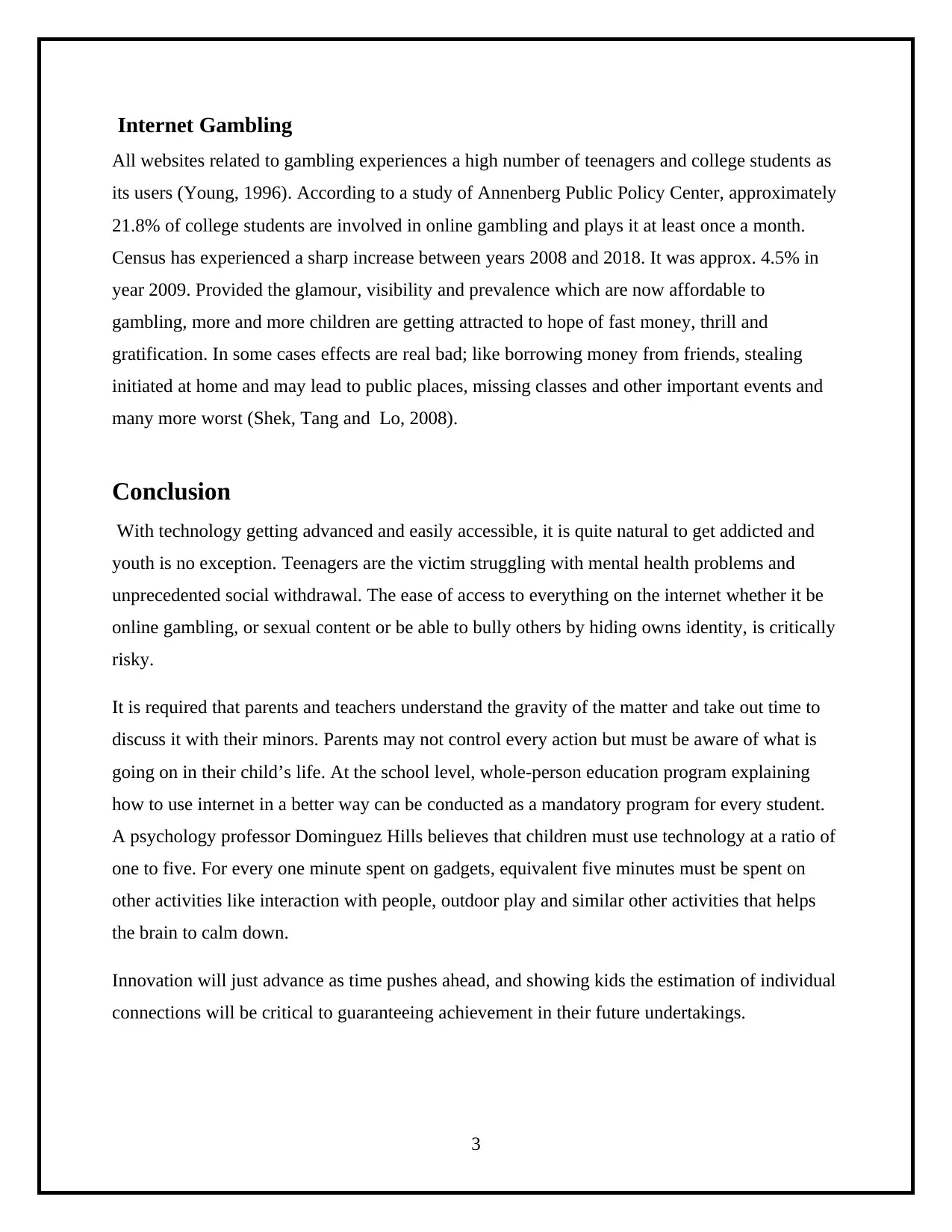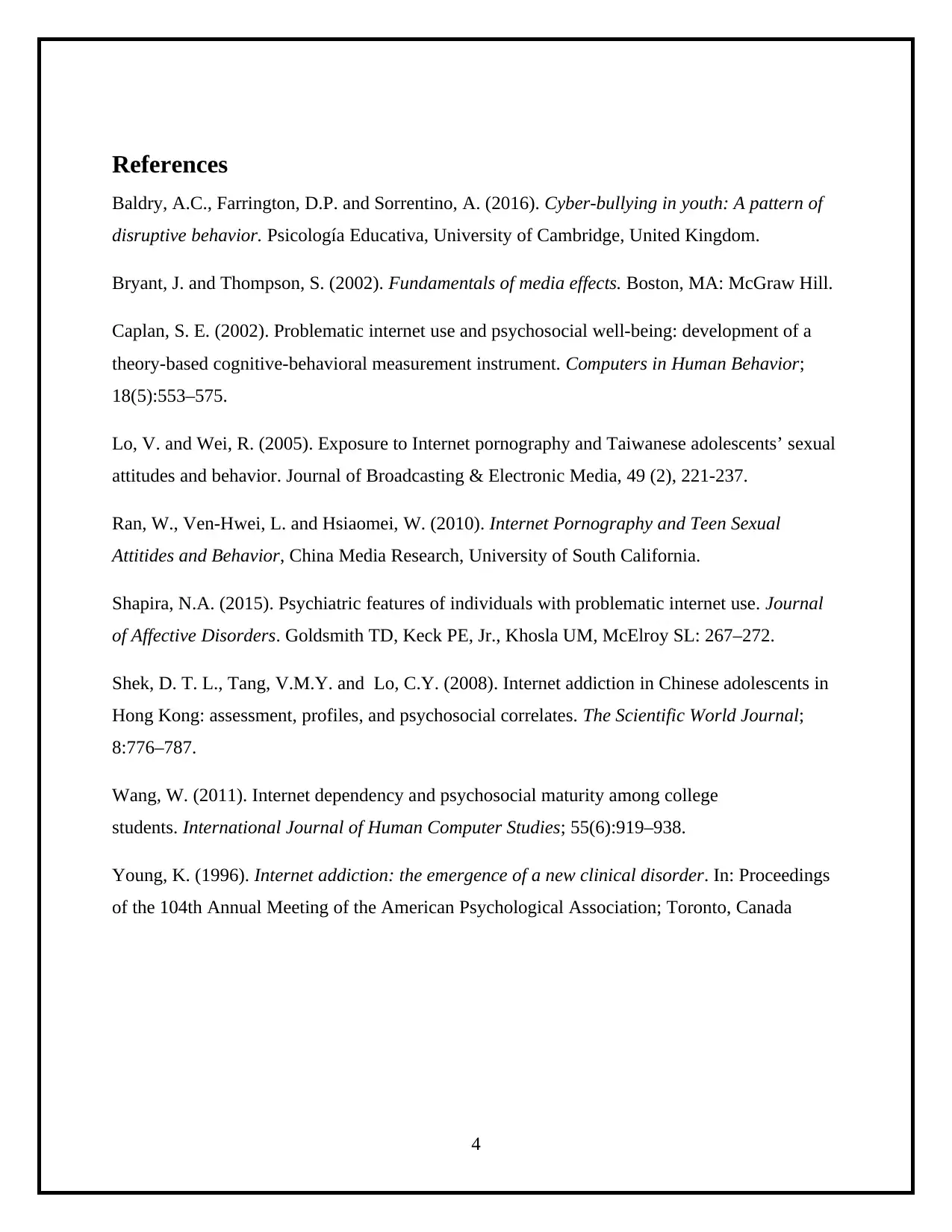The Internet and Anti-Social Youth: A Persuasive Analytical Essay
VerifiedAdded on 2023/06/07
|5
|1569
|414
Essay
AI Summary
This persuasive essay examines the argument that the internet is creating a generation of anti-social youth. It discusses the increasing use of technology and the internet, leading to addiction and reduced peer interaction, potentially causing children to become anti-social. The essay explores anti-social internet behaviors such as accessing pornography, cyberbullying, and online gambling, providing evidence from surveys and studies. It argues that easy access to these online activities poses risks to teenagers, contributing to mental health problems and social withdrawal. The essay concludes by emphasizing the importance of parental and teacher involvement in guiding children's internet use and promoting real-world interactions. Resources like this, including past papers and solved assignments, are available on Desklib to aid students in their studies.

qwertyuiopasdfghjklzxcvbnmqwe
rtyuiopasdfghjklzxcvbnmqwertyu
iopasdfghjklzxcvbnmqwertyuiopa
sdfghjklzxcvbnmqwertyuiopasdfg
hjklzxcvbnmqwertyuiopasdfghjkl
zxcvbnmqwertyuiopasdfghjklzxcv
bnmqwertyuiopasdfghjklzxcvbnm
qwertyuiopasdfghjklzxcvbnmqwe
rtyuiopasdfghjklzxcvbnmqwertyu
iopasdfghjklzxcvbnmqwertyuiopa
sdfghjklzxcvbnmqwertyuiopasdfg
hjklzxcvbnmqwertyuiopasdfghjkl
zxcvbnmqwertyuiopasdfghjklzxcv
Persuasive Analytical Essay
The internet is creating a generation of ‘anti - social youth.’
rtyuiopasdfghjklzxcvbnmqwertyu
iopasdfghjklzxcvbnmqwertyuiopa
sdfghjklzxcvbnmqwertyuiopasdfg
hjklzxcvbnmqwertyuiopasdfghjkl
zxcvbnmqwertyuiopasdfghjklzxcv
bnmqwertyuiopasdfghjklzxcvbnm
qwertyuiopasdfghjklzxcvbnmqwe
rtyuiopasdfghjklzxcvbnmqwertyu
iopasdfghjklzxcvbnmqwertyuiopa
sdfghjklzxcvbnmqwertyuiopasdfg
hjklzxcvbnmqwertyuiopasdfghjkl
zxcvbnmqwertyuiopasdfghjklzxcv
Persuasive Analytical Essay
The internet is creating a generation of ‘anti - social youth.’
Paraphrase This Document
Need a fresh take? Get an instant paraphrase of this document with our AI Paraphraser

Introduction
The use of technological gadgets and internet are increasing rapidly. Addiction of the internet
and no peer interaction are making children anti-social. This paper discusses the moral
consequences of antisocial internet activities and their harsh effects. The topic of argument is
whether using internet is making children anti-social.
Community parks, which used to be crowded with children playing all over, making noises and
doing all sort of stuff that makes them happy and healthy can now be seen filled with silence and
loneliness and witnesses rare visitors. All thanks to the technology and internet effects. A survey
done by a NGO ‘Save the Children’ told in their report that more than 75 % of teachers believe
that internet has severely damaged kid’s ability to socialize (Caplan, 2002) . They spent long
hours locked in their rooms and indulged in their gadgets. It has also been reported that children
who tried to disconnect themselves by switching off their gadget for 24 hour period felt so lonely
and had no idea how to fill up the extra time (Shapira, 2015).
The effects are serious; many of the children feels themselves isolated in their own world, some
turn out to be anti-social and opt to bully other children out of all the frustration instead of
connecting to their guardians (Wang, 2011). The following activities are considered to be a part
of anti-social internet behavior.
Using network to perform unlawful activities, for example, watching porn material and
selling fake products.
Indulging in cyber bullying i.e. using internet to bully others, for example, spreading
offensive articulations against someone in particular.
Using internet to carry out illegal gambling and cheating others.
Internet Pornography
It is broadly noted that web provides imprudent access of porn content in abundance and
teenagers are exploiting themselves with it. Results of a survey conducted in Taiwan show that
around 42.8% of high school students has access porn materials on internet. Accessing sexual
content on web could lead to sexual permissiveness behavior of the teenager. Empirical
evidences from the number of conducted studies have proved that there is a link between
1
The use of technological gadgets and internet are increasing rapidly. Addiction of the internet
and no peer interaction are making children anti-social. This paper discusses the moral
consequences of antisocial internet activities and their harsh effects. The topic of argument is
whether using internet is making children anti-social.
Community parks, which used to be crowded with children playing all over, making noises and
doing all sort of stuff that makes them happy and healthy can now be seen filled with silence and
loneliness and witnesses rare visitors. All thanks to the technology and internet effects. A survey
done by a NGO ‘Save the Children’ told in their report that more than 75 % of teachers believe
that internet has severely damaged kid’s ability to socialize (Caplan, 2002) . They spent long
hours locked in their rooms and indulged in their gadgets. It has also been reported that children
who tried to disconnect themselves by switching off their gadget for 24 hour period felt so lonely
and had no idea how to fill up the extra time (Shapira, 2015).
The effects are serious; many of the children feels themselves isolated in their own world, some
turn out to be anti-social and opt to bully other children out of all the frustration instead of
connecting to their guardians (Wang, 2011). The following activities are considered to be a part
of anti-social internet behavior.
Using network to perform unlawful activities, for example, watching porn material and
selling fake products.
Indulging in cyber bullying i.e. using internet to bully others, for example, spreading
offensive articulations against someone in particular.
Using internet to carry out illegal gambling and cheating others.
Internet Pornography
It is broadly noted that web provides imprudent access of porn content in abundance and
teenagers are exploiting themselves with it. Results of a survey conducted in Taiwan show that
around 42.8% of high school students has access porn materials on internet. Accessing sexual
content on web could lead to sexual permissiveness behavior of the teenager. Empirical
evidences from the number of conducted studies have proved that there is a link between
1

sexually permissive behavior and using media related to sexual explicit content (Bryant &
Thompson, 2002). Howard studied the beliefs of 1000 teenagers regarding their own sexuality
and discovered that pop music and television had pressurized them to get engaged in porn
activities.
There is an argument about the topic that if the sexual information is provided via human
medium and not internet then will it makes a change in the behavior pattern. I believe yes
because getting right knowledge at right time in a right manner is necessary to avoid its harsh
consequences (Ran, Ven-Hwei and Hsiaomei, 2010). If the knowledge regarding sex will be
introduced in a right manner it will surely make a difference. Also, Lo and Wei reported in their
study that more the level of access to porn more the level of sexual permissively behavior, so via
human medium things will remain in limit and its negative effects can be avoided (Lo and Wei,
2005).
Cyber-bullying
Cyber-bullying can be characterized as 'a forceful demonstration or conduct which has been
performed via electronic medium by either an individual or a group against a victim. Based on
the report of studies conducted it has been found that problem of cyber-bullying is widespread
and is highly found between the age group 12 to 17 years (Baldry, Farrington and Sorrentino,
2016). Also, there has been found out a significant overlap between cyber and school bullying.
The students who were bullied electronically were also bullied at school sometime. The
moment a kid start using web and social applications for the purpose of interaction and
communication, same moment he/she becomes susceptible to risks against cyber-bullying and at
some point of time may invert his role of being a cyber-victim by starting bullying others out of
frustration (Baldry, Farrington and Sorrentino, 2016).
The major factors to start bullying someone can be related to low empathy, poor supervision
from teachers and parents, isolation etc. One could argue that, we cannot call a person cyber-
victim until the teasing happened five to six times over a month. I do not agree to this point. We
cannot define a criterion for the person to be categorized under cyber-victim depending upon the
frequency. Sometimes one action could be more devastating than five to six multiple actions
depending on how the internet works like fire in today’s world. Information specially rumors and
false new spreads in no time and could make cyber-victim to go under depression.
2
Thompson, 2002). Howard studied the beliefs of 1000 teenagers regarding their own sexuality
and discovered that pop music and television had pressurized them to get engaged in porn
activities.
There is an argument about the topic that if the sexual information is provided via human
medium and not internet then will it makes a change in the behavior pattern. I believe yes
because getting right knowledge at right time in a right manner is necessary to avoid its harsh
consequences (Ran, Ven-Hwei and Hsiaomei, 2010). If the knowledge regarding sex will be
introduced in a right manner it will surely make a difference. Also, Lo and Wei reported in their
study that more the level of access to porn more the level of sexual permissively behavior, so via
human medium things will remain in limit and its negative effects can be avoided (Lo and Wei,
2005).
Cyber-bullying
Cyber-bullying can be characterized as 'a forceful demonstration or conduct which has been
performed via electronic medium by either an individual or a group against a victim. Based on
the report of studies conducted it has been found that problem of cyber-bullying is widespread
and is highly found between the age group 12 to 17 years (Baldry, Farrington and Sorrentino,
2016). Also, there has been found out a significant overlap between cyber and school bullying.
The students who were bullied electronically were also bullied at school sometime. The
moment a kid start using web and social applications for the purpose of interaction and
communication, same moment he/she becomes susceptible to risks against cyber-bullying and at
some point of time may invert his role of being a cyber-victim by starting bullying others out of
frustration (Baldry, Farrington and Sorrentino, 2016).
The major factors to start bullying someone can be related to low empathy, poor supervision
from teachers and parents, isolation etc. One could argue that, we cannot call a person cyber-
victim until the teasing happened five to six times over a month. I do not agree to this point. We
cannot define a criterion for the person to be categorized under cyber-victim depending upon the
frequency. Sometimes one action could be more devastating than five to six multiple actions
depending on how the internet works like fire in today’s world. Information specially rumors and
false new spreads in no time and could make cyber-victim to go under depression.
2
⊘ This is a preview!⊘
Do you want full access?
Subscribe today to unlock all pages.

Trusted by 1+ million students worldwide

Internet Gambling
All websites related to gambling experiences a high number of teenagers and college students as
its users (Young, 1996). According to a study of Annenberg Public Policy Center, approximately
21.8% of college students are involved in online gambling and plays it at least once a month.
Census has experienced a sharp increase between years 2008 and 2018. It was approx. 4.5% in
year 2009. Provided the glamour, visibility and prevalence which are now affordable to
gambling, more and more children are getting attracted to hope of fast money, thrill and
gratification. In some cases effects are real bad; like borrowing money from friends, stealing
initiated at home and may lead to public places, missing classes and other important events and
many more worst (Shek, Tang and Lo, 2008).
Conclusion
With technology getting advanced and easily accessible, it is quite natural to get addicted and
youth is no exception. Teenagers are the victim struggling with mental health problems and
unprecedented social withdrawal. The ease of access to everything on the internet whether it be
online gambling, or sexual content or be able to bully others by hiding owns identity, is critically
risky.
It is required that parents and teachers understand the gravity of the matter and take out time to
discuss it with their minors. Parents may not control every action but must be aware of what is
going on in their child’s life. At the school level, whole-person education program explaining
how to use internet in a better way can be conducted as a mandatory program for every student.
A psychology professor Dominguez Hills believes that children must use technology at a ratio of
one to five. For every one minute spent on gadgets, equivalent five minutes must be spent on
other activities like interaction with people, outdoor play and similar other activities that helps
the brain to calm down.
Innovation will just advance as time pushes ahead, and showing kids the estimation of individual
connections will be critical to guaranteeing achievement in their future undertakings.
3
All websites related to gambling experiences a high number of teenagers and college students as
its users (Young, 1996). According to a study of Annenberg Public Policy Center, approximately
21.8% of college students are involved in online gambling and plays it at least once a month.
Census has experienced a sharp increase between years 2008 and 2018. It was approx. 4.5% in
year 2009. Provided the glamour, visibility and prevalence which are now affordable to
gambling, more and more children are getting attracted to hope of fast money, thrill and
gratification. In some cases effects are real bad; like borrowing money from friends, stealing
initiated at home and may lead to public places, missing classes and other important events and
many more worst (Shek, Tang and Lo, 2008).
Conclusion
With technology getting advanced and easily accessible, it is quite natural to get addicted and
youth is no exception. Teenagers are the victim struggling with mental health problems and
unprecedented social withdrawal. The ease of access to everything on the internet whether it be
online gambling, or sexual content or be able to bully others by hiding owns identity, is critically
risky.
It is required that parents and teachers understand the gravity of the matter and take out time to
discuss it with their minors. Parents may not control every action but must be aware of what is
going on in their child’s life. At the school level, whole-person education program explaining
how to use internet in a better way can be conducted as a mandatory program for every student.
A psychology professor Dominguez Hills believes that children must use technology at a ratio of
one to five. For every one minute spent on gadgets, equivalent five minutes must be spent on
other activities like interaction with people, outdoor play and similar other activities that helps
the brain to calm down.
Innovation will just advance as time pushes ahead, and showing kids the estimation of individual
connections will be critical to guaranteeing achievement in their future undertakings.
3
Paraphrase This Document
Need a fresh take? Get an instant paraphrase of this document with our AI Paraphraser

References
Baldry, A.C., Farrington, D.P. and Sorrentino, A. (2016). Cyber-bullying in youth: A pattern of
disruptive behavior. Psicología Educativa, University of Cambridge, United Kingdom.
Bryant, J. and Thompson, S. (2002). Fundamentals of media effects. Boston, MA: McGraw Hill.
Caplan, S. E. (2002). Problematic internet use and psychosocial well-being: development of a
theory-based cognitive-behavioral measurement instrument. Computers in Human Behavior;
18(5):553–575.
Lo, V. and Wei, R. (2005). Exposure to Internet pornography and Taiwanese adolescents’ sexual
attitudes and behavior. Journal of Broadcasting & Electronic Media, 49 (2), 221-237.
Ran, W., Ven-Hwei, L. and Hsiaomei, W. (2010). Internet Pornography and Teen Sexual
Attitides and Behavior, China Media Research, University of South California.
Shapira, N.A. (2015). Psychiatric features of individuals with problematic internet use. Journal
of Affective Disorders. Goldsmith TD, Keck PE, Jr., Khosla UM, McElroy SL: 267–272.
Shek, D. T. L., Tang, V.M.Y. and Lo, C.Y. (2008). Internet addiction in Chinese adolescents in
Hong Kong: assessment, profiles, and psychosocial correlates. The Scientific World Journal;
8:776–787.
Wang, W. (2011). Internet dependency and psychosocial maturity among college
students. International Journal of Human Computer Studies; 55(6):919–938.
Young, K. (1996). Internet addiction: the emergence of a new clinical disorder. In: Proceedings
of the 104th Annual Meeting of the American Psychological Association; Toronto, Canada
4
Baldry, A.C., Farrington, D.P. and Sorrentino, A. (2016). Cyber-bullying in youth: A pattern of
disruptive behavior. Psicología Educativa, University of Cambridge, United Kingdom.
Bryant, J. and Thompson, S. (2002). Fundamentals of media effects. Boston, MA: McGraw Hill.
Caplan, S. E. (2002). Problematic internet use and psychosocial well-being: development of a
theory-based cognitive-behavioral measurement instrument. Computers in Human Behavior;
18(5):553–575.
Lo, V. and Wei, R. (2005). Exposure to Internet pornography and Taiwanese adolescents’ sexual
attitudes and behavior. Journal of Broadcasting & Electronic Media, 49 (2), 221-237.
Ran, W., Ven-Hwei, L. and Hsiaomei, W. (2010). Internet Pornography and Teen Sexual
Attitides and Behavior, China Media Research, University of South California.
Shapira, N.A. (2015). Psychiatric features of individuals with problematic internet use. Journal
of Affective Disorders. Goldsmith TD, Keck PE, Jr., Khosla UM, McElroy SL: 267–272.
Shek, D. T. L., Tang, V.M.Y. and Lo, C.Y. (2008). Internet addiction in Chinese adolescents in
Hong Kong: assessment, profiles, and psychosocial correlates. The Scientific World Journal;
8:776–787.
Wang, W. (2011). Internet dependency and psychosocial maturity among college
students. International Journal of Human Computer Studies; 55(6):919–938.
Young, K. (1996). Internet addiction: the emergence of a new clinical disorder. In: Proceedings
of the 104th Annual Meeting of the American Psychological Association; Toronto, Canada
4
1 out of 5
Your All-in-One AI-Powered Toolkit for Academic Success.
+13062052269
info@desklib.com
Available 24*7 on WhatsApp / Email
![[object Object]](/_next/static/media/star-bottom.7253800d.svg)
Unlock your academic potential
Copyright © 2020–2025 A2Z Services. All Rights Reserved. Developed and managed by ZUCOL.